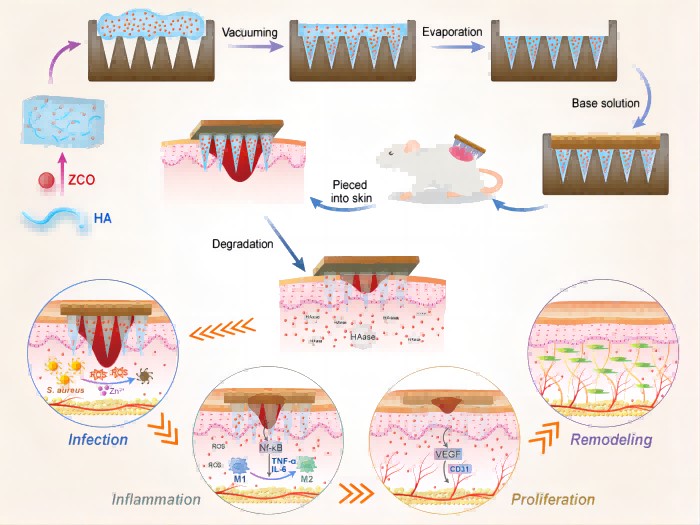Recently, Pro. Qian Haisheng from School of Biomedical Engineering published “Multifunctional Hyaluronic Acid Microneedle Patch Embedded by Cerium/Zinc-based Composites for Accelerating Diabetes Wound Healing” in Advanced Healthcare Materials (IF=11.092). The findings provide a new approach to solving the complicated and dynamic problems of the wound surface of diabetes patients and accelerating wound healing. With Prof. Qian Haisheng working as the first corresponding author, his postgraduate student Yang Juan is the first author, and AHMU is the first author affiliation.

Diabetes patients may develop hyperglycemia and various complications, including cardiovascular diseases, nerve damage (neuropathy), kidney damage (kidney disease), eye damage (retinopathy), hearing impairment, dementia, and especially delayed wound healing, which is one of the most serious complications of diabetes.
Professor Qian Haisheng’s team has developed a new active material AA-[Zn(OH)4]2-/Ce(ZCO), and encapsulate it in a multicomponent enzyme-responsive natural polymer, a hyaluronic acid (HA) microneedle, creating a ZCO-HA microneedle. The microneedle can slowly release ZCO because of the enzyme sensitivity of HA, while Zn2+ is rapidly released to destroy the oxidation balance of bacteria, which can cause oxidative stress to damage DNA, proteins, and lipids, and ultimately kill drug-resistant bacteria. In the stage of inflammation, the adjustable release of Zn2+ and Ce3+/4+ scavenge reactive oxygen species (ROS) to alleviate oxidative stress. Additionally, ZCO-HA exhibits good anti-inflammatory activity through the nuclear factor kappa-B (NF-κB) pathway to reduce the inflammatory state of macrophages. In the stage of proliferation, ZCO-HA accompanies proliferation and migration of fibroblasts and endothelial cells to the wound by promoting the expression of vascular endothelial growth factor (VEGF) and platelet endothelial cell adhesion molecule (CD31), resulting in granulation tissue formation and collagen deposition, and ultimately acceleration of the wound healing of diabetes.
Source: https://doi.org/10.1002/adhm.202300725
